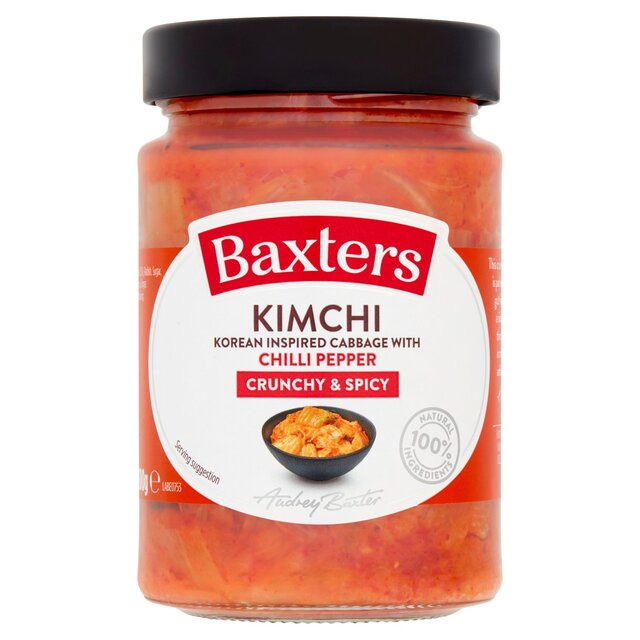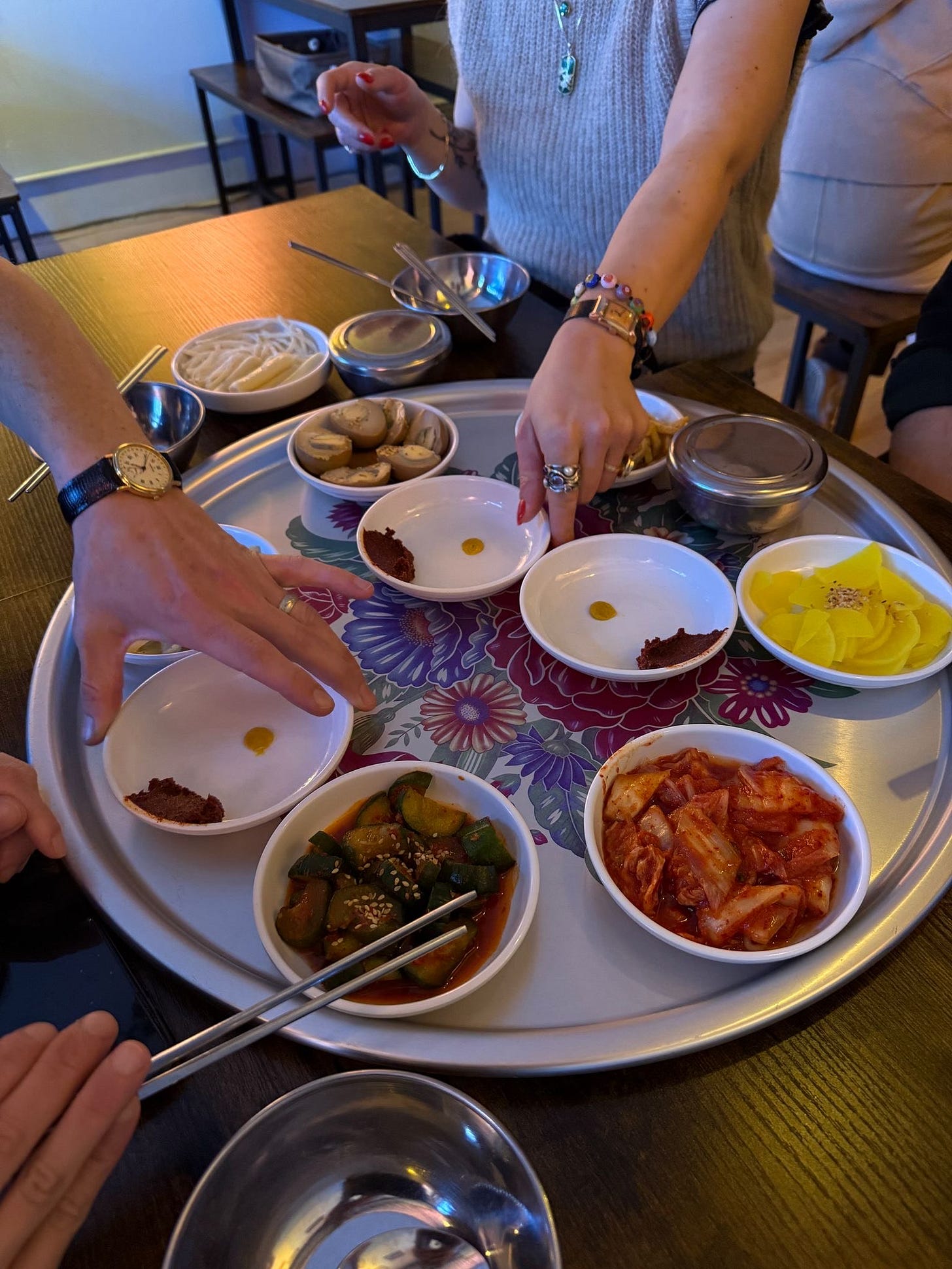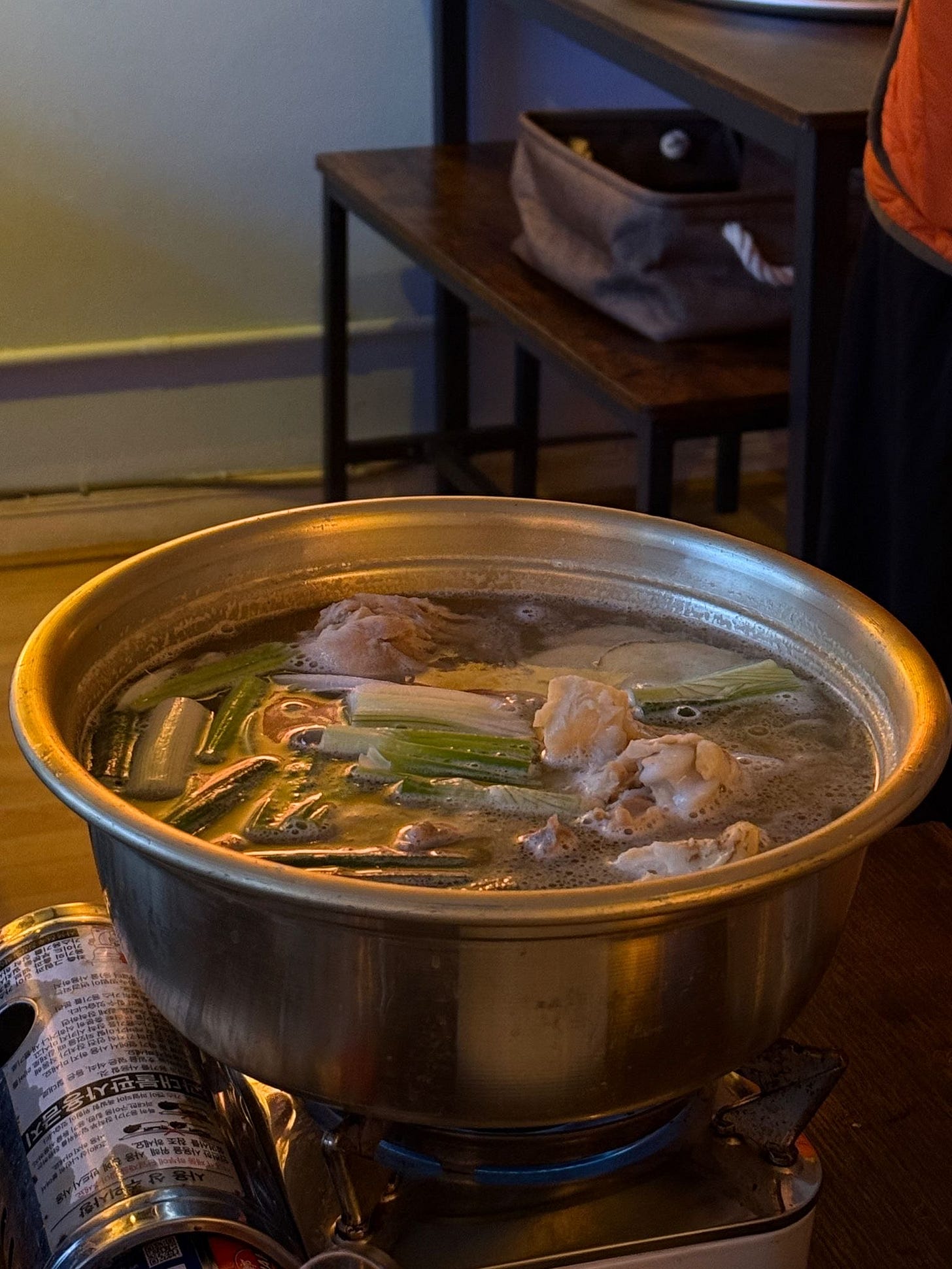Beyond Fried Chicken
The curious rise of Korean food in the UK. Words by Yuna Chang and Ha-Joon Chang. Illustration by David Huang.
Good morning, and welcome to Vittles! Today, Yuna Chang and Ha-Joon Chang write about the unlikely factors that enabled the growth and escalation of Korean cuisine in the UK.
Pre-orders for Issue 1 of Vittles are now closed until next week. We will start sending out magazines from the week of May 5th before reopening orders again (apologies that this is a few days later than originally expected).
Beyond Fried Chicken
The curious rise of Korean food in the UK. Words by Yuna Chang and Ha-Joon Chang. Illustration by David Huang.
It is a Thursday evening in 2002. As dusk falls over Cambridge, cars start to pull into the driveway of a local church. The people emerging from their vehicles greet each other in Korean, loitering in small groups until a large white lorry arrives. The back doors of the lorry swing open to the waiting crowd and a warm light floods the darkening asphalt, revealing… a single aisle of a supermarket suspended above the concrete. This aisle has been transported all the way from New Malden – the UK’s Koreatown, located on the edges of south-west London. On its shelves sit Korean essentials like rice, myulchi-jut (fermented anchovy sauce), and gochugaru (Korean chilli powder). You have one chance to go down this aisle and pick up what you need for the next few weeks, so being prepared is essential. Once the last person has been down the aisle, the lorry packs up and drives off into the darkness. It will return in a fortnight or so.
In the late 1990s and early 2000s, the fortnightly lorry was how our family would access Korean ingredients; even this was only possible because Cambridge, with its university and Science Park, had a larger concentration of Koreans than most other UK towns. For those goods that the fortnightly mobile supermarket could not deliver, we would drive, once every few months, to New Malden. Otherwise a classic English suburb, with its high street and terraced houses, New Malden was also the unlikely home for the largest community of South Koreans in the UK. This gathering came about because the South Korean Embassy and Samsung UK were located there in the 1970s; it’s said that New Malden was the only area in London that the then cash-poor South Koreans could afford. By the turn of the millennium, the Korean population in the UK had grown to 12,000 – a motley combination of students, visiting scholars, businesspeople and civil servants on foreign dispatch. This in itself was a huge increase from number in the hundreds in the 1980s, when, in order to conserve foreign currency, the South Korean government heavily restricted international travel. Those was a time when, if you said you were from Korea, people would ask, ‘Is that in China or Japan?’
In those days, we experienced Korean food like a boa constrictor might – in the few days after New Malden, we’d be able to eat to our fancy, maybe even treating ourselves to kimchi jjigae (which, with its liberal use of the titular ingredient, is only possible in kimchi-rich times). A few weeks later, we’d start to ration ingredients until it was time to brave the long journey again.
Today, things have changed. The Korean Embassy has moved from New Malden to the impossibly affluent Buckingham Gate in central London. People no longer ask where Korea is – in fact, Korean food is everywhere you look in London, from the pop-up Bibigo food trucks outside King’s Cross station to the novelty Korean instant noodle shop on the posh streets of Kensington. Across the UK, Tesco stocks Shin Ramyun, Honest Burger does a Kimchi Burger with ‘Korean burger sauce’, Domino’s Pizza sells ‘Korean BBQ Chicken Pizza’, and Scandi bakery Ole & Steen boasts a ‘Kimchi and Cheddar Croissant’. Scottish food processor Baxters has topped it all by describing its Kimchi as ‘Korean inspired cabbage with chilli pepper’.
As Koreans who have lived through the fortnightly car-park-supermarket-lorry rationing days, it’s both fascinating and confusing to see the meteoric rise of our cuisine across just two decades. Even as we are relieved that we can now easily access Korean food around London, we’ve also been curious to figure out what lies behind this rapid escalation in popularity. Though finding Korean food may now be straightforward, the journey to get here has been far less so.
Korean food hasn’t trodden the route of other popular cuisines in the UK, such as Chinese or Indian. These food cultures have spread outwards from a critical mass of immigrants, in many cases driven by the colonial migration routes forged by the reach of the British Empire. In Britain, they have grown organically, through rough pockets of cooking – from Cantonese immigrants taking over chippies and takeaways to Bangladeshi-owned curry houses – slowly opening notoriously conservative British tastebuds up to the rest of the world. Yet compared to the 502,000 Chinese or 290,000 Italians living in the UK, Koreans usually resident in the UK[1] officially total 21,000 people, a negligible 0.03% of the population (the actual percentage, which includes more transitory populations like students, is said to be around 0.06%, which is still tiny when compared to 0.5% for the US). Korean food owes a debt of gratitude to the cuisines that pioneered the path and allowed for its rapid uptake, but it has clearly not entered the British mainstream in the same way. Instead, Korean food has come in on the back of a cultural wave, as Korea’s various exports have meant the idea of Korea itself has become ‘cool’.
Today, Koreans are winning Academy Awards and the Nobel Prize in Literature, and your latest phone and electric car are probably Korean. K-pop bands like BTS and BlackPink have gone global, and, following the phenomenal success of Korean TV series such as Squid Game, K-dramas are also reaching far wider audiences around the world. By consequence, any food appearing in a Korean TV series or movie now has a huge global audience. Squid Game gave dalgona (a nostalgic street food for Koreans that, over the past decade, has been hard to find) international popularity; now, stalls in Korea catering to tourists label the food ‘As seen in Squid Game’ for curious foreigners. This explosion of Korean culture is known as ‘Hallyu’ (literally, Korean Wave) in Korean, defined somewhat smugly by the Korean Cultural Centre as ‘the global craze for Korean culture’[2]. In 2024, a ‘State of Hallyu’ survey, released by the South Korean Ministry of Culture, asked, ‘What comes to mind when you think of Korea?’ The top answer was K-pop (17.2%), followed by Korean food (13.2%), then K-dramas (7%)[3]; in other words, Korean food is just one (important) part of a wider global craze about the country.

So, if Korean food has found mainstream popularity through the Korean wave (rather than the slow, organic spread of cooking by migrant chefs), who is stewarding our Korean food experience? In the UK, much of the spread of Korean food has been driven by corporations that have recognised the commercial opportunity of Hallyu and put serious money and marketing muscle behind promoting Korean cuisine. So instead of local corner shops run by Koreans, you get supermarket chains like Seoul Plaza – the retail name of Korea Foods, a distributor established in New Malden in 1999[4] – and Oseyo, the glitzy newcomer springing up all over London (which also happens to be the UK arm of the giant US Asian supermarket chain H Mart).
You’re not very likely to find a Korean granny cooking in the kitchen of your favourite Korean Soho spot – Instagram-popular ‘viral’ joints such as Bunsik (Korean street food), Pochawa Grill (Korean BBQ), and Itaewon Burger & Chicken are actually all owned by the same corporation, Maguro Group. Maguro was, until recently, the UK distributor of Korean skincare brand Nature Republic, and also owns Cobalt, an Asian-style nail and spa, and Maguro Sushi, a Japanese restaurant. Businesses like Maguro capitalise on selling Korean food as an experience – modern, fun, and trendy. Their food ranges from passable and overpriced (Bunsik) to actually quite good (Pochawa Grill). For these businesses, though, the quality of the food is only one part of the recipe – they’re selling an idea of Korea, capitalising on and perpetuating the perception of the country as seen in K-pop music videos and Instagram influencers’ content.
But in the drive to turn a quick profit, the food available through these savvy corporate initiatives tends to cater to lowest-common-denominator trends of guaranteed successes – like gochujang, fried chicken and K-BBQ. It almost feels redundant to say that this perception obscures the reality and breadth of Korean food, offering a narrow view of the nation’s food culture; Chinese takeaway owners who serve their anglicised menu to customers and cook completely different dishes for their kids would say the same.
For Koreans, everyday fare is not the meat-heavy indulgence of the K-BBQ, but our balanced meal of the 밥상 [bap-saang], literally meaning rice (bap) table (saang). Bap-saang presents a bowl of bap, a gook (soup) or jjigae (stew), and six or seven dishes of banchan, literally meaning ‘accompaniment to rice’. The banchan are normally small, communal dishes made with vegetables, plus one or two bigger items such as a meat or a fish dish. At the bap-saang, the eater assembles each morsel as they fancy – the first mouthful may simply be rice and a spoonful of spinach doenjang gook (doenjang being a fermented soybean paste, a more pungent cousin of Japanese miso) while the next morsel, taking a wild turn, may be a mouthful of rice topped with bulgogi (grilled meat – usually beef) and kimchi. Every bite has the potential to be a different dish, each diner creating a unique world in the mouth.
The bap-saang is a marvel of resourceful and generous cooking, and it’s for this reason that corporation-backed Korean restaurants are unlikely to introduce it. Last year, UK restaurant closures were their highest in a decade – a November 2024 study by accounting firm Price Bailey found that 10% of UK restaurants were at risk of closure in the next twelve months[5]. The standard capitalist logic often asserts that high levels of competition will lead to innovation, but such cut-throat competition has actually created a restaurant industry that shies away from risk-taking and creativity. This has enabled corporation-backed joints riding TikTok trends to outcompete the owner–chefs who may try to keep up a tradition, be proud of artisanal skills, or revel in wild creativity.
Perhaps because of all this, Korean food in the UK often panders to the Western way of eating, dividing dishes that are supposed to be eaten together at the bap-saang into artificial courses. Kimchi pancakes are usually classed as an appetiser, while jjigae has achieved the hallowed status of a main. This is exacerbated by social media, which tends to emphasise star dishes (‘You HAVE to try this viral Korean corn dog!’) that completely go against how Korean food is usually presented and eaten. We’re not saying that bap-saang is more ‘real’ or ‘authentic’ (whatever your definition of that controversial word may be) than other types of Korean food. But we hope that these formulaic and hyper-curated experiences of Korean food in the UK may soon give way to the more exploratory nature of the humble bap-saang.
All industries, even restaurants and food establishments, require a period of ‘market creation’. In the case of Korean food, this journey was curated by Hallyu and a set of hungry corporations, on a compressed timeline of about twenty years – at odds with the literal century-long journey of Chinese food in the UK. And while this has exposed the uglier parts of the corporatised food industry, such a narrowed and watered-down vision doesn’t have to be the destiny of Korean food in the UK.
From the ashes of the Korean BBQ Pizza at Domino’s have risen restaurants such as Ogam, Miga, and Bonga; they offer fare underpinned by a deeper understanding of culinary traditions, and are more creative in their offerings. Tucked away in a street off Angel’s Chapel Market, Gamnamuzip serves banchan on large metal trays next to tabletop stoves with simmering stews, which fog up the windows, the framed Korean school certificates, and the childhood pictures of the owner. As our family tucks into this meal on a cold winter’s day, the restaurant fills up with Koreans and non-Koreans alike, and we cannot quite believe that we are witnessing a restaurant full of non-Koreans enjoying gamjatang (pork spine stew) and platters of jokbal (pork trotters). These restaurants seed our hope that we, whether cook or diner, can look beyond packaged trends and curate our own journey through different culinary paths. Beyond the friendly favourites of fried chicken and gochujang, a whole world of flavours awaits.
This article was amended to correct the percentages of Korean people in the UK, which is 0.03-0.06% rather than 0.0003-0.0006%.
Credits
Yuna Chang is an independent researcher working on climate and ecological justice.
Ha-Joon Chang is a professor of economics at SOAS University of London and the author of Edible Economics.
David Huang is an illustrator and designer based in London. His work can be found on his website.
The full Vittles masthead can be found here.







My family lives in New Malden, and I know so much more about Korean food and culture from reading this. You have answered many curiosities of mine. Thank you, Yuna!
Having relatively recently got into Korean food - we're lucky enough to have two excellent Korean restaurants in Bristol, Bokman and Dongnae - I'm probably exactly the kind of person you're writing about! Absolutely loved my recent meal at Miga too - and your book Edible Economics Ha-Joon Chang! Useful post - thankyou!